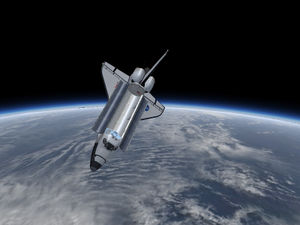Space Shuttle: Difference between revisions
(Created page with "{{SpaceFlight}} {{infobox Aircraft |image = Shuttle FG01.jpg |alt = Space Shuttle Atlantis in orbit |name = Space Shuttle |type = Spa...") |
|||
| Line 30: | Line 30: | ||
== Project Aim == | == Project Aim == | ||
The aim of the Shuttle Project is to create a highly realistic simulation of the capabilities of the Space Shuttle in Flightgear. While most of the time the real Shuttle is under the control of automatic guidance systems, there are fallback modes to control the spacecraft manually, the so-called CSS (control stick steering) modes, and it is these modes we primarily try to implement. | |||
In addition to the real avionics and control modes, the idea is also to provide various 'educational' modes and instruments such as to explore and appreciate certain aspects of a Shuttle mission more. | |||
The [http://ntrs.nasa.gov NASA technical reports server] supplies a large base of wind tunnel and in-situ performance data of both the mated launch vehicle and the orbiter, and the aerodynamics of the simulated shuttle is based on these documents. The authoritive source for procedures for trajectory management, instrumentation, limits and energency procedures is the [https://www.nasa.gov/centers/johnson/pdf/390651main_shuttle_crew_operations_manual.pdf|Space Shuttle Crew Operations Manual] and currently a normal mission, i.e. ascent, orbital insertion, de-orbit, entry, terminal area energy management and landing can be flown largely 'by the book', i.e. following the real procedure. As of May 2015, this does not yet hold for emergency procedures. | |||
Revision as of 10:02, 17 May 2015
| Space flight |
|---|
| in FlightGear |
| Space Shuttle |
| Vostok-1 |
 Space Shuttle Atlantis in orbit | |
| Type | Spacecraft |
|---|---|
| Author(s) | Thorsten Renk, Richard Harrison |
| FDM | JSBSim |
| --aircraft= | SpaceShuttle |
| Status | Beta |
| FDM |
|
| Systems |
|
| Cockpit |
|
| Model |
|
| Download |
|
The NASA Space Shuttle was the world's first operational space plane capable of reaching orbit. It was operated from 1981 to 2011 on a total of 135 missions during which two orbiters, Challenger and Columbia, were lost in accidents.
The Shuttle launch system components include the Orbiter Vehicle (OV), a pair of solid rocket boosters (SRBs) and the external tank (ET) containing the liquid hydrogen and oxygen fuel for the engines of the orbiter. Out of these, only the external tank is expendable, the SRBs splash into the sea shortly after launch and are recovered, and the orbiter itself returns to a landing site where it lands like an airplane.
The mixture of a rocket-like launch, a spacecraft-like near ballistic early atmospheric phase and an airplane like approach and landing makes the Space Shuttle a truly unique flying experience.
Project Aim
The aim of the Shuttle Project is to create a highly realistic simulation of the capabilities of the Space Shuttle in Flightgear. While most of the time the real Shuttle is under the control of automatic guidance systems, there are fallback modes to control the spacecraft manually, the so-called CSS (control stick steering) modes, and it is these modes we primarily try to implement.
In addition to the real avionics and control modes, the idea is also to provide various 'educational' modes and instruments such as to explore and appreciate certain aspects of a Shuttle mission more.
The NASA technical reports server supplies a large base of wind tunnel and in-situ performance data of both the mated launch vehicle and the orbiter, and the aerodynamics of the simulated shuttle is based on these documents. The authoritive source for procedures for trajectory management, instrumentation, limits and energency procedures is the Shuttle Crew Operations Manual and currently a normal mission, i.e. ascent, orbital insertion, de-orbit, entry, terminal area energy management and landing can be flown largely 'by the book', i.e. following the real procedure. As of May 2015, this does not yet hold for emergency procedures.
